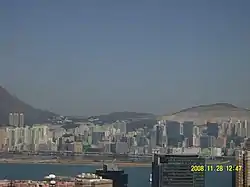New Kowloon
New Kowloon is an area in Kowloon, Hong Kong, bounded in the south by Boundary Street, and in the north by the ranges of the Lion Rock, Beacon Hill, Tate's Cairn and Kowloon Peak. It covers the present-day Kwun Tong District and Wong Tai Sin District, and part of the Sham Shui Po District and Kowloon City District.
New Kowloon
新九龍 | |||||||||||||||||||||||||||||||||||||
|---|---|---|---|---|---|---|---|---|---|---|---|---|---|---|---|---|---|---|---|---|---|---|---|---|---|---|---|---|---|---|---|---|---|---|---|---|---|
area | |||||||||||||||||||||||||||||||||||||
 Eastern New Kowloon (Kowloon Bay, Kwun Tong, etc.) | |||||||||||||||||||||||||||||||||||||
| Etymology: Name after Kowloon Peninsula | |||||||||||||||||||||||||||||||||||||
 Approx. location of New Kowloon (in red), compare to the Kowloon geographical constituencies of the Legislative Council (in green); Note that former Kai Tak Airport reclaimed land (also coloured in green) did not exist until WWII. | |||||||||||||||||||||||||||||||||||||
| Country | China | ||||||||||||||||||||||||||||||||||||
| SARs | Hong Kong | ||||||||||||||||||||||||||||||||||||
| Regions (non-administrative) | New Territories / Kowloon | ||||||||||||||||||||||||||||||||||||
| New Kowloon separated from Kowloon | 1860 | ||||||||||||||||||||||||||||||||||||
| New Kowloon (as part of New Territories) leased to Hong Kong | 1898 | ||||||||||||||||||||||||||||||||||||
| New Kowloon split from New Territorties | 1937 | ||||||||||||||||||||||||||||||||||||
| Time zone | UTC+8 | ||||||||||||||||||||||||||||||||||||
| |||||||||||||||||||||||||||||||||||||
The name of this area is rarely use in day to day life. Areas that belongs to New Kowloon are usually referred as Kowloon. However, in land lease, it is common to refer the land lot as New Kowloon Inland Lot number #.
History
Prior to Convention of Peking in 1860, the territory of British-owned Kowloon was originally defined as area in Kowloon Peninsula south of Boundary Street (known as Kowloon and Stonecutter's Island), which was ceded by the Qing Empire to the United Kingdom under the Convention.
On the other hand, the territory north of Boundary Street (later known as New Kowloon) remained part of Qing Empire until it was leased as part of the New Territories to the UK in 1898 for 99 years under the Convention for the Extension of Hong Kong Territory (also known as the Second Convention of Peking). The area of New Kowloon was defined by law in 1937 to increase land available for urban development.[1][2] In practice, nevertheless, both the areas to the south and to the north of Boundary Street (i.e. both Kowloon and New Kowloon), from the Lei Yue Mun strait in the east to Mei Foo Sun Chuen and Lai Chi Kok Bay in the west, are collectively known as "Kowloon". For example, a postal address in Kwun Tong will identify "Kowloon" as its regional destination, even though it is technically in New Kowloon and not part of Kowloon as statutorily defined.
Current situation
In modern-day conversations, the term "New Kowloon" is now rarely heard in Hong Kong. New Kowloon is no longer regarded as part of the New Territories, but as a part of the Kowloon urban area beyond Boundary Street. Nevertheless, the legal definitions of Kowloon, New Kowloon and New Territories remain unchanged - New Kowloon has remained legally part of the New Territories instead of Kowloon.[3] On 1 July, 1997, the territories on both sides of Boundary Street (ceded and leased respectively) were transferred to China, along with the rest of Hong Kong.
However, the designation "New Kowloon" still has some legal implications. Almost all lands of Hong Kong are government land (known as crown land in Commonwealth countries), while all crown leases (now known as government leases in HK) of New Kowloon and New Territories lands had been expired on 27 June 1997, but automatically extended up to 30 June 2047 due to the Sino-British Joint Declaration.[4] This renewal implies that, all privately owned land leases of New Kowloon, has to pay government rent (crown rent in Commonwealth countries), unlike the rest of the Kowloon.[5] Most Kowloon land lease (Kowloon south of the Boundary Street) does not requires to pay the government rent to the government, unless it has been renewed and such clause was inserted in the renewed lease contract.
The land reclaimed from the Kowloon Bay water body, such as Kai Tak, are also referred as part of New Kowloon in land leases,[6] although these lots do not appear to be included in the 1937 map.
See also
References
- Sched 5 to the IGCO
- Plan marked “New Kowloon” dated 8 December 1937, signed by the Director of Public Works, countersigned by the Governor and deposited in the Land Registry.
- Schedules 4, 5 and 5A, Interpretation and General Clauses Ordinance (IGCO), HK Law Cap. 1
- Annex III, – via Wikisource.
- "Government Rent". Hong Kong: Rating and Valuation Department. 1 August 2019. Retrieved 6 December 2020.
- "Government to sell site in Kai Tak by public tender". info.gov.hk (Press release). Hong Kong Government. 23 October 2020. Retrieved 3 December 2020.
External links
| Wikimedia Commons has media related to New Kowloon. |